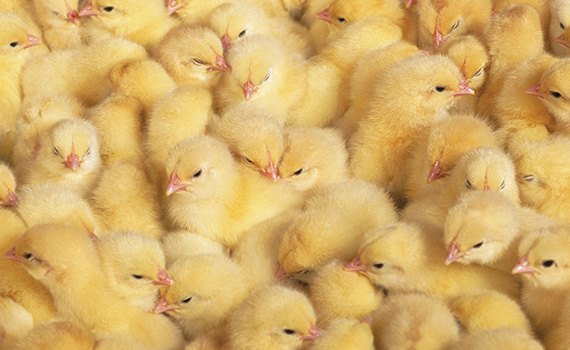Successful Marek’s disease vaccination: The devil is in the details

By Don Ritter, DVM, ACPV
Senior Director of Health Services and Food Safety
Mountaire Farms Inc.
Marek’s disease (MD) is a worldwide problem in broiler production, and it’s of increasing concern in poultry-dense areas where the disease challenge is high. This is especially true for operations growing large broilers.
Here on the Delmarva Peninsula, MD has been a persistent challenge since 1923, when the commercial broiler industry was founded. MD viruses isolated from broilers in our region are consistently classified as VV++ — the most virulent classification and the type that leads to immunosuppression.
We’ve learned that successful MD control requires vigilance and a carefully planned and administered MD vaccination program. Otherwise, losses can add up quickly.
Before we discuss vaccination programs, however, let’s briefly review the disease’s etiology and its effect on poultry operations.
Condemnations
MD, caused by an oncogenic alphaherpesvirus, results in neuropathy and lymphomatous tumors of the skin and internal organs in older broilers. Under the category of “leukosis,” USDA inspectors condemn whole birds with visible MD tumors at processing. Leukosis condemnations are usually very low but can soar if the MD vaccination program is ineffective.
In the Delmarva region, leukosis condemnations peak in May, when the last winter-started flock is processed. Environmental loads of MD virus decline during summer months, when ventilation rates are highest, then build up again in winter in a seasonal cycle.
Roaster challenge
Chickens, however, don’t have to show tumors to be infected with the virus. In fact, they often become persistently infected without developing clinical disease or tumors. Despite the absence of clinical signs, the virus can replicate in feather follicles and is shed in dander.
Because they’re in the house longer, older chickens shed more contaminated dander, particularly into the litter, which is commonly reused. This is why MD is more of a problem for producers growing large broilers. Chicks in the next flock are challenged with MD virus, a phenomenon we used to call the “roaster challenge.”
Vaccination options
Vaccination greatly reduces clinical MD, including tumor formation, but it doesn’t prevent persistent infection and virus shed. Vaccination helps prevent clinical MD when administered in ovo at 18 or 19 embryonic days or by using live-MD vaccines on the day of hatch.
MD vaccines are available in three serotypes and as vector vaccines:
- Attenuated oncogenic strains (Serotype 1), such as Rispens
- Naturally non-oncogenic strains (Serotype 2), such as SB1 and 301B
- A non-oncogenic herpesvirus of turkey (HVT, Serotype 3).
- Vector vaccines using HVT as a carrier virus for Newcastle disease virus, infectious laryngotracheitis virus or infectious bursal disease virus antigens.
Serotype 2 and 3 vaccines are considered synergistic when administered together, while Serotype 1 vaccines are stand-alone additions to a combination program. For heavy broilers in high-challenge areas, producers often use a multivalent vaccination strategy consisting of one vaccine from each of the three serotypes. Such a trivalent vaccine program — most commonly HVT + SB1 + Rispen — is costly but essential to prevent losses due to MD.
Vector HVT vaccines are becoming more popular in U.S. vaccination programs for Marek’s Disease. It’s important to note that due to viral interference, a vector HVT cannot be mixed with regular HVT vaccines. In addition, vector vaccines usually don’t reach titers that are equal to the parent HVT virus and may not be as protective for MD in some situations where the challenge from MD is high. Thus, dilution of vector HVT viruses is generally not recommended.
Preserving vaccine viability
Cell-associated live viral MD vaccines are frozen in liquid nitrogen. Proper vaccine handling and administration are vital to preserve their viability. After carefully thawing and mixing the vaccine into buffered diluent, a small volume (0.05 ml) is injected in ovo using automated equipment. Proper vaccination is also of paramount importance because these vaccines do not spread from bird to bird — a missed vaccination is a miss.
The addition of an antibiotic to the vaccine diluent for administration to the embryo together with the vaccine is detrimental and has been shown to decrease the viable vaccine titer by 20% to 40%, depending on the strain.[1]
Onset of immunity
Because a natural challenge to the MD virus begins immediately after placement of chicks into a highly contaminated chicken house, the success of the vaccination program is dependent on rapid onset of immunity. The vaccines are basically in a foot race with virulent field strains of the MD virus to replicate and immunize the chicken to prevent tumor formation and immunosuppression. Thus, the most effective vaccines must produce rapid onset of viremia and subsequent onset of immunity.
Vaccines are titrated as plaque-forming units (PFUs) using cell-culture techniques. Vaccines with higher PFU levels enhance the rapid onset of viremia. In addition, vaccines manufactured from master seeds that have been passed less times in cell culture — vaccine viruses that are “closer to the bird” — are generally considered more protective than vaccines produced from highly passed viruses.
An optimal MD vaccination program for a poultry-dense region, therefore, would include trivalent HVT (or vector HVT) + SB1 + Rispen with the highest PFUs available of low-passed viruses. Such a combination is especially critical during the high environmental challenge conditions of winter months.
Never-ending challenge
A fact about MD is that once effective control gets away from you, it doesn’t end with one flock. When control is lost, the environmental load becomes so high that it takes several subsequent flocks of highly vaccinated chicks to bring that load back down to a reasonable level where normal control can be maintained again.
In my experience, major economic losses due to MD in the Delmarva region have occurred due to vaccination mistakes. Examples include use of a vaccine that was dead due to mishandling (thawing), debris in the vaccine manifolds of the in ovo injection machine due to needle damage to plastic diluent bag ports, or using a vaccine with a titer and a dose dilution that together were too low. Careful attention to detail is critical to successful vaccine application, and frequent auditing by managers or others adds another level of security to this important process.
Although MD presents a never-ending challenge that requires constant vigilance, successful control is possible with carefully planned and administered MD vaccination programs.
[1] Ritter DG. Hatchery vaccination and vaccine preparation: key factor of success and failures.
Posted on June 14, 2016
 We’re glad you’re enjoying
We’re glad you’re enjoying










